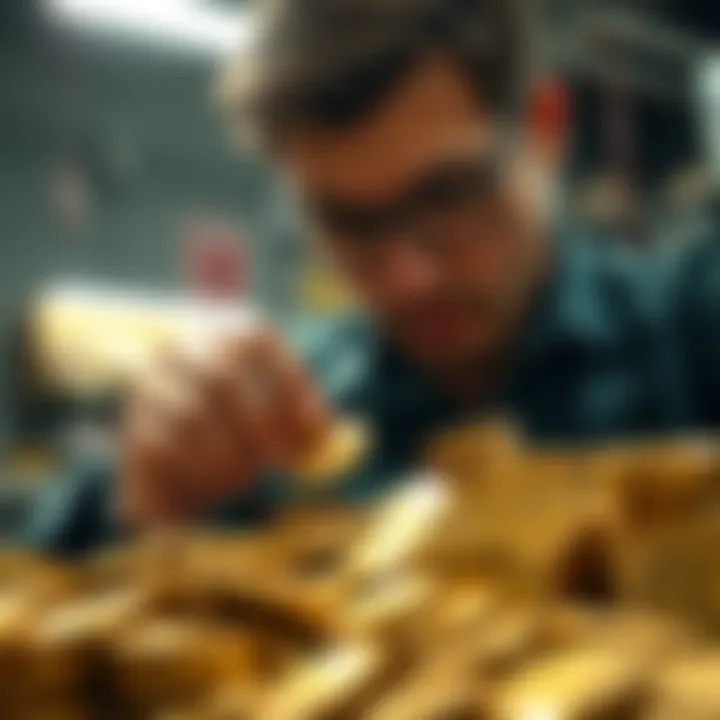Navigating the Local Gold and Silver Marketplace


Intro
This article aims to shed light on the intricate dance of buying and selling precious metals in your area. By delving into the motivations behind the investment, the practical steps to find trustworthy dealers, and the factors that affect pricing, we equip you with essential knowledge. Whether you're a fledgling investor tipping your toes into the market or a seasoned buyer with experience tucked under your belt, your journey through the world of gold and silver will become a more informed one.
Let's break down some fundamental investment terms that can elevate your understanding and bolster your confidence in this market.
Intro to Precious Metal Investing
Investing in precious metals, namely gold and silver, has long been regarded as a cornerstone of financial strategy for individuals seeking to cultivate wealth and stability. This section delves into the foundational tenets of why precious metals hold a significant place in investment portfolios and how they can be beneficial in a myriad of financial scenarios.
Definition and Importance of Precious Metals
Precious metals are naturally occurring elements that hold economic value. Gold and silver are the most prominent of these, coveted not just for their intrinsic beauty but also for their rarity. The importance of these metals transcends mere aesthetic appeal; they serve as a tangible asset, particularly during turbulent economic times.
They are viewed as a hedge against currency devaluation, providing a sense of security that intangible investments often lack. In essence, when the stock markets tumble or inflation rises, the value of gold and silver tends to remain stable, acting as a safe haven for investors. Investing in these metals can diversify an investment portfolio, reducing overall risk while offering potential for growth.
Investors should understand that the significance of precious metals often correlates with global uncertainties, making them an essential piece of the puzzle when considering financial health.
Historical Context
The story of gold and silver is woven deep in the fabric of human history, dating back thousands of years. Ancient civilizations, from the Egyptians to the Romans, recognized the value of these metals, using them not only for jewelry and decoration but also as currency.
Fast forward to the modern era, and the role of precious metals has evolved but remains as critical as ever. The Gold Standard, for instance, once positioned gold as the cornerstone of monetary policy, influencing international trade and currency valuation. Although the world moved away from fixed currency systems, the intrinsic qualities of gold and silver ensure that they maintain intrinsic value.
Today, the historical reliability of these metals contributes to their appeal. Investors often take cues from historical market trends, analyzing how gold and silver performed in times of economic crisis, political upheaval, and inflationary periods. Understanding this context not only informs current investment strategies but also cultivates a reasonable expectation of how these markets might behave in the future. Those who delve into the past are often better equipped for the present, making it essential to acknowledge where precious metals have come from.
"In times of economic uncertainty, gold and silver act as a stabilizing force, reminding us of their historical significance as a store of value."
As we embark on this exploration of the local gold and silver marketplace, it becomes clear that understanding the foundational aspects of precious metal investing sets the stage for strategic decision-making regarding buying, selling, and engaging with local dealers.
Understanding Gold and Silver Markets
Grasping the nuances of the gold and silver markets is crucial for any individual looking to invest in these precious metals. The dynamics at play not only shape pricing but also influence market strategies for both novice and experienced investors alike. In this section, we’ll delve into the key elements that define this marketplace, shedding light on how to navigate its complexities for better investment decisions.
Market Dynamics
The gold and silver markets are driven by a multitude of factors, each intertwining to create a fluid tapestry of opportunity and risk. At the heart of these markets are supply and demand fundamentals. Since gold and silver are finite resources, with mining yields impacted by geopolitical factors, economic conditions, and technological advancements, their availability fluctuates. As a result, prices can take unexpected turns.
Demand fluctuations can stem from various industries. For example, the jewelry sector remains one of the largest consumers, particularly in regions like India and China, where cultural significance amplifies demand during festival seasons. Additionally, the industrial demand for silver, found in electronics and solar panels, has been on the rise, influencing its market trends distinctly.
Investment demand also plays a critical role. During periods of economic instability, many investors flock to gold and silver as a sanctuary for their assets. The perception of these metals as safe havens results in price surges, reflecting their intrinsic value. This prospective may cause one to feel like a sailor on a stormy sea if unprepared, but understanding these dynamics helps mitigate the turbulence.
"Understanding the market dynamics is like being equipped with a compass; it guides your decisions amidst uncertainty, allowing you to make informed choices in turbulent waters."
Global Influencers
Going beyond local conditions, the gold and silver markets are heavily influenced by global phenomena. International relations, central bank policies, and macroeconomic indicators can all send ripples through these markets.
For instance, major central banks around the world, like the Federal Reserve in the United States or the European Central Bank, possess significant gold reserves. Their buying and selling decisions can sway market sentiment and pricing significantly. Speculations on interest rates, inflation, and currency strength are crucial, as gold typically moves inversely to strength in other currencies. Therefore, when the dollar gets weaker, gold prices often trend upward.
In another vein, geopolitical instabilities, such as conflicts, elections, or economic sanctions, can also raise the stakes in the gold and silver arena. Investors often seek the shelter of these metals when uncertainty reigns, creating price spikes during crises. Keeping an eye on global news is akin to checking the weather before heading out; it informs the decision on when or whether to invest.
Investors must stay vigilant about these global influencers. Ignoring them could mean missing out on significant market movements. By studying both the intrinsic and extrinsic factors affecting gold and silver, you can develop a sharper edge in your investing journey.
Why Invest in Gold and Silver?
Investing in gold and silver has long been seen as a reliable strategy for protecting wealth and securing financial futures. As you navigate the complexities of the local gold and silver marketplace, understanding the motivations behind these investments is crucial. This section explores the reasons why individuals turn to precious metals, highlighting specific elements that make them attractive options for both new and seasoned investors.
Hedge Against Inflation
One of the primary reasons people invest in gold and silver is to hedge against inflation. Throughout history, the value of fiat currencies has fluctuated due to various economic factors, leading to the erosion of purchasing power. With inflation rates climbing or expectations of rising costs looming, precious metals tend to retain their value over time.


When inflation strikes and money becomes worth less, gold and silver often rise in value. Here are a few key points that demonstrate how they act as a shield against inflation:
- Intrinsic Value: Unlike paper currency, gold and silver have inherent value derived from their physical properties and rarity.
- Limited Supply: The availability of gold and silver is constrained by mining output, making them less susceptible to fluctuations in paper money supply.
- Global Demand: As countries around the world face potential currency devaluation, demand for these metals often spikes, driving up their prices.
Thus, investing in gold and silver can be viewed as a prudent response to the unpredictability of economic conditions, allowing investors to keep pace with or even outstrip inflationary pressures.
Safe Haven in Uncertain Times
Another compelling reason to consider gold and silver is their status as safe haven assets. When economic uncertainty looms—be it from geopolitical tensions, financial crises, or global pandemics—investors often flock to precious metals as a refuge. These assets are perceived as a safe bet for several reasons:
- Stability: Gold and silver provide a stable form of wealth, often maintaining their value when markets are volatile.
- Non-Correlated to Traditional Investments: Unlike stocks or bonds, precious metals do not necessarily follow the same market trends, making them a unique avenue for diversification.
- Historical Safety: There’s a long-standing tradition of turning to these metals in times of crisis, which provides an emotional comfort to investors.
"In the world of investing, gold and silver often shine brightest during the storm."
As you consider whether to buy or sell, recognizing the role of gold and silver as a safety net can guide your decisions. Knowledge of these factors not only prepares you for unpredictable market conditions but also serves as a framework for long-term investment strategies.
In summary, with inflation on the rise and economic unpredictability at the forefront, investing in gold and silver remains a vital consideration for anyone serious about securing their financial future. Understanding why these metals are valued can greatly enhance your approach to the local marketplace.
Finding Local Dealers: A Step-by-Step Approach
When it comes to building a solid foundation in precious metal investing, finding local dealers is pivotal. This segment not only aims to direct you to the right contacts but also emphasizes the practicality of engaging with trusted experts in your vicinity. By navigating through the local marketplace, you will gain access to personalized service and insights that may not surface through online transactions. Whether you’re a novice or an experienced investor, the presence of a reliable local dealer can simplify the complexities involved in trading gold and silver.
Researching Nearby Options
The first step in your journey is to dive into research. It's crucial to identify potential dealers in your area who specialize in gold and silver. Various resources exist to aid in this search:
- Online Platforms: Websites such as Yelp and Google Maps can reveal local dealers, along with reviews and ratings from previous customers. Look for businesses that have consistent positive feedback.
- Forums and Community Groups: Online communities, especially those on Reddit, can provide personal experiences and recommendations. Discussions could reveal dealers that locals trust.
- Local Trade Shows: Attending regional events or expos can provide firsthand interaction with dealers. This allows you to observe the products and gauge the atmosphere at the dealer's booth, which can be quite revealing.
Local dealers can vary wildly in terms of product offerings and pricing. Therefore, it’s smart to create a shortlist of potential candidates based on your research. Remember, having multiple options gives you leverage, both in terms of variety and price negotiations. And, it’s always wise to keep your ear to the ground for word-of-mouth recommendations.
Evaluating Dealer Credibility
Once you have a list of local dealers, the next layer of assessment is evaluating their credibility. This aspect is non-negotiable in ensuring that your investments are secure. Here’s how to approach it:
- Check for Licensure and Certification: Legitimate dealers often hold licenses and certifications from recognized authorities. This signifies their compliance with local regulations. Look for affiliations with organizations such as the Numismatic Guaranty Corporation or the American Numismatic Association.
- Request References: Don’t hesitate to ask for references from previous clients. A reputable dealer should be willing to provide contacts who can vouch for their service.
- Visit in Person: If possible, visiting the dealer’s physical location can swiftly give you a feel for their professionalism. A clean, organized, and secure environment often indicates a more trustworthy business.
"The more informed you are before entering a deal, the less likely you are to fall into costly traps."
- Look for Transparency: A trustable dealer will openly share their pricing structure, including any fees involved. If a dealer is evasive when discussing costs, that’s a potential red flag.
- Customer Service: Gauge their willingness to answer your questions. A credible dealer should display patience and thoroughness, ensuring you feel comfortable about your transactions.
By thoroughly researching nearby options and rigorously evaluating dealer credibility, you're setting the stage for successful investments in gold and silver. With a solid understanding of your local marketplace, you will navigate the challenges of precious metal transactions with greater confidence.
The Buying Process
Understanding the buying process when it comes to gold and silver is crucial for any investor. Having a solid grasp not only ensures that you're making informed decisions, but it also empowers you to engage with dealers confidently. There’s a blend of art and science in this process, where emotions can run high and practical knowledge can make all the difference. Making the right moves now can lead to rewarding investments later.
Identifying the Right Product
When it comes to investing in precious metals, knowing which product to purchase is half the battle. There are various types of gold and silver available in the market. Here are some common ones:
- Coins: These are often favored by many investors for their ease of trade and liquidity. Popular choices include the American Gold Eagle and the Canadian Maple Leaf.
- Bars: Gold or silver bars tend to be more cost-effective in terms of premiums over the spot price. However, make sure to purchase from reputable sources to avoid counterfeits.
- Jewelry: While not always the best form of investment due to markup costs, vintage or high-quality pieces can appreciate in value.
Choosing the right product involves more than just personal preference; consider liquidity, portability, and your overall investment goals. A novice investor might go for coins due to their recognizability, while seasoned investors might lean towards larger bars to minimize premiums.
Negotiating Price
Once you've identified the product you want, the next step is to negotiate the price. Negotiation is an art that requires you to be well-prepared and shrewd. Understanding current market trends is key—gold and silver prices fluctuate based on numerous factors, including global economic conditions, currency values, and market speculation.
Here are a few tips to keep in mind while negotiating:
- Know the Spot Price: Always be aware of the current spot price of gold and silver. This knowledge arms you with the information you need to avoid overpaying.
- Don’t Hesitate to Walk Away: If you feel the terms do not align with the market conditions, don't be afraid to decline the deal. There are other dealers out there.
- Build Rapport: Establishing a good relationship with dealers can work wonders. Sometimes a friendly chat can lead to better deals than a cold transaction.
"Knowledge is power in the world of precious metals investment. The more you know, the better the deals you can strike."


Investors need to remember that the market is ever-changing. Keeping abreast of global trends and local dealer reputation can significantly aid in not just buying, but in determining when to sell.
In essence, the buying process involves a multi-faceted approach from product selection to price negotiation. Being informed not only aids in securing the best deals, but it also builds a level of confidence that instills trust and credibility in the eyes of the dealers.
Selling Gold and Silver: Key Considerations
Selling gold and silver is not just a transaction; it's a nuanced process fraught with opportunities and potential pitfalls. Understanding the key considerations surrounding this activity can make all the difference in maximizing profit and minimizing regret. Think of it as navigating a labyrinth—knowing the right path can lead you to riches, while ignorance can leave you scrambling in the dark.
Timing the Market
When it comes to selling precious metals, timing is as crucial as knowing where to sell. The fluctuations within gold and silver markets can be as unpredictable as the weather. One day it might be sunny, with prices soaring; the next day could turn dreary with a drop. Therefore, understanding market trends is a necessity.
Key Factors to Consider:
- Market Trends: Regularly monitor the spot prices for gold and silver. Websites like Kitco provide daily updates.
- Economic Indicators: Keep an eye on economic reports like inflation rates, employment data, and geopolitical tensions. They can all influence precious metal prices.
- Seasonality: Historically, some months see higher demand for metals—influencing prices. For instance, holidays often prompt jewelry purchases, impacting gold prices.
Investing a little time in market research can be highly beneficial. Timing your sale can help you turn a modest transaction into a lucrative one.
Preparing for Sale
When you decide to sell, preparation is key—think of it as getting ready for an important presentation. This isn’t just about shiny metals; it involves meticulous planning and attention to detail.
Steps to Prepare:
- Gather Documentation: Collect any papers that prove authenticity, such as receipts or certificates from dealers. Investors appreciate transparency and history.
- Assess Condition: How does your gold jewelry look? Is there wear, damage, or has it been well cared for? The state of your items can significantly influence offers.
- Get Multiple Quotes: Don’t settle for the first offer you receive. Like shopping for a car, it pays to compare quotes from different dealers. This will give you a clearer picture of your item’s value.
- Know Your Numbers: Understand what you are willing to accept, and also the minimum you’re prepared to take. This knowledge empowers you during negotiations.
"Preparation is the key to success. It’s not just the gold or silver you sell; it’s the value you bring as a knowledgeable seller."
Valuing your items accurately goes beyond merely looking at weight and current market prices. Evaluate the historical significance, rarity, and craftsmanship involved. The right preparation position you not just as a seller, but as a smart investor ready to make prudent decisions.
Potential issues can arise during selling; scams and dishonesty exist. Evaluating the dealer’s reputation and understanding the sales process is essential for a successful transaction.
Understanding Pricing and Valuation
Factors Influencing Price
A myriad of factors come into play when determining the price of gold and silver, each interconnecting in a web of economic significance.
- Supply and Demand: The most rudimentary principle guiding prices in any market. If demand for gold spikes—perhaps due to global unrest or market volatility—prices typically soar. Conversely, if supply exceeds demand, as might happen with a new wave of mining, prices can plummet.
- Market Sentiment: Investor psychology is a significant player here. When fear creeps into the economy, gold often shines brighter as it’s traditionally seen as a safe haven. It’s almost as if the collective consciousness pushes the price according to emotion rather than pure economic rationale.
- Currency Strength: The value of the U.S. dollar bears heavy weight on the pricing of gold and silver. When the dollar is weak, precious metals become more expensive overseas, thus impacting global demand and potentially driving prices up.
- Interest Rates: There’s an inverse relationship between interest rates and precious metal prices. Lower rates make bullion more appealing compared to yield-bearing assets, enhancing demand and thus raising prices.
- Geopolitical Events: Political turmoil or conflicts can serve as catalysts for price fluctuations. Investors often flock to gold as a protective measure, elevating its valuation in uncertain times.
Understanding these factors not only aids in anticipating price movements but can also guide strategic buying and selling decisions.
"In precious metals trading, knowledge of market dynamics becomes your strongest ally."
Market Indices
Market indices serve as crucial benchmarks for gauging the health and trends within the gold and silver sectors. Two of the most referenced indices include:
- London Bullion Market Association (LBMA) Gold Price: Often seen as the global standard, the LBMA Gold Price is established twice daily and provides a forthcoming view on gold valuation across various markets.
- Silver Institute's Price Assessment: This index is vital for monitoring silver prices and includes comprehensive data on supplies and sales, proving valuable for understanding market health.
For investors, monitoring these indices isn’t just a useful exercise; it’s a matter of necessity. These figures assist in not only understanding current market conditions but can also signal trends that might impact future prices. Thus, staying informed about these indices can lead to more informed decisions when participating in the local gold and silver marketplace.
Precautions and Risks in Precious Metal Transactions
Investing in gold and silver can be a gratifying venture, but it doesn’t come without its fair share of caveats. Being aware of the precautions and risks associated with precious metal transactions is crucial for any investor – whether you are a seasoned trader or a newbie just dipping your toes into the market. There’s a lot at stake, and understanding these elements can better protect your investment and enhance your overall experience.
Red Flags to Watch For
When dealing in precious metals, it’s imperative to stay sharp and watch for warning signs that could indicate a scam or a dishonest transaction. Here are a few red flags:
- Too Good to Be True Deals: If a dealer is offering prices that seem unbelievably low compared to the market rate, it’s likely a bait-and-switch strategy.
- Pressure Sales Tactics: A salesperson who insists that you must act now or lose out is usually not looking out for your best interests. A legitimate dealer respects your decision-making process.
- Lack of Transparency: Unwillingness to provide clear documentation regarding the quality and origin of the metals should cause concern. Always demand to see certifications.
- Harsh Return Policies: A dealer who will not accept returns or has overly complicated return policies may not be trustworthy.


These red flags are signals that can help you navigate the often rocky terrain of precious metal investment. Trust your instincts; if something feels off, it’s better to err on the side of caution.
Legal and Tax Considerations
Investing in gold and silver involves more than just conducting a transaction; it also has a legal and tax dimension that you shouldn’t overlook. Being informed about these regulations can save you from unexpected consequences later on. Here are key considerations to keep in mind:
- Reporting Requirements: Depending on where you live, you might need to report any precious metal transactions over a certain value. Ignoring this could lead to legal trouble down the road.
- Sales Tax Implications: In some jurisdictions, the sale of precious metals can be subject to sales tax. Always check your local laws before making a purchase to avoid unwelcome surprises.
- Capital Gains Tax: When you sell your precious metals, you may be liable for capital gains taxes if they appreciate in value. Ensure you keep accurate records of your purchases, as these will be essential for calculating your tax liability.
- Regulatory Compliance: Be aware of any federal and state regulations surrounding buying and selling precious metals. Legislation can vary significantly based on location.
Staying on top of these legal and tax considerations not only protects you but also enhances your standing as a responsible investor.
"Investing in precious metals is not just about the metals themselves; it’s about navigating the waters of legality and risk with a steady hand."
In the end, by being vigilant and informed, you will significantly reduce the risks associated with your investments in gold and silver. This knowledge doesn't just safeguard your transactions – it empowers you to engage with the market more confidently.
Alternative Investment Routes
When it comes to investing in precious metals, the traditional route of buying physical gold and silver isn’t the only game in town. Many savvy investors are looking at alternative routes that offer unique benefits and considerations. Exploring these routes can diversify your portfolio while keeping your investments exposed to the changing tides of the precious metal markets.
Gold and silver exchange-traded funds (ETFs) and mining stocks are two popular alternatives worth considering. They provide different avenues for gaining value, mitigate some risks associated with physical ownership, and offer liquidity that physical assets often lack. Let’s delve deeper into each option, weighing their merits and potential drawbacks.
Gold and Silver ETFs
Gold and silver ETFs are a popular way for investors to gain exposure to precious metals without the need to buy physical assets. An ETF is essentially a collection of assets that tracks the price of gold or silver. Investors purchase shares just as they would with stock, making it simple to buy and sell in real-time—ideal for those who wish to make quick trades and not deal with the hassle of storage or insurance of physical metals.
Benefits of Gold and Silver ETFs:
- Liquidity: ETFs can be bought and sold instantly during market hours, offering flexibility.
- Cost-effective: You typically avoid the high premiums that come with buying physical coins or bars.
- Diversification: Investing in an ETF allows for immediate exposure to a broader range of assets, possibly lowering individual risk.
- No storage concerns: Since you're not dealing with physical metals, there's no need to worry about safe storage or rising security fees.
However, consider the fees that some ETFs may charge, including management fees and expenses. Additionally, the appreciation of ETFs is linked directly to the price of the metals, meaning you won't have the same tangible asset to rely on in a crisis as with physical gold or silver.
Mining Stocks and Mutual Funds
Another alternative route involves investing in mining stocks or mutual funds that focus on companies engaged in the exploration and production of gold and silver. These investments can yield high returns but come with their own set of risks. Mining operations can be affected by a myriad of factors—everything from political strife in a mining region to fluctuating costs of labor and materials.
Key Considerations for Mining Stocks and Mutual Funds:
- Growth Potential: Mining companies often have significant growth potential, especially if they discover new reserves.
- Dividend Payments: Some mining stocks pay dividends, providing an additional income stream.
- Leverage on Metal Prices: As metals rise in value, mining stocks often see a more considerable percentage value increase due to operational leverage.
However, investing in mining stocks can be riskier. The volatility of the shares may be influenced by factors unrelated to metal prices, such as management issues, production costs, and market sentiment about the mining industry itself. For those wanting to venture into this area, conducting thorough research on specific companies and their operating environments is crucial.
"Diversity in investment is key; it spreads the risk but doesn’t guarantee profits."
In sum, alternative investment routes like ETFs and mining stocks can offer practical options for those looking to dip their toes into the precious metals market without the complexities of ownership. Each path has distinct pros and cons, positioning them as suitable for different strategic approaches in an investor's journey.
Closure: Making Informed Decisions
Making informed decisions when buying and selling gold and silver is crucial. The precious metals market can be tricky, with fluctuations that are affected by a multitude of factors like economic trends, political climates, and even seasonal demand. Thus, brushing up your knowledge before diving in can make the difference between a wise investment and a costly mistake.
Investing in precious metals isn't just about monetary gain; it’s also about securing a piece of stability in an unpredictable world. Therefore, your ability to discern the right time to buy or sell is essential. Understanding the market dynamics, local dealer credibility, and potential legal implications will give you a firmer footing.
At the end of the day, making informed decisions means you’re not just riding the wave but directing your own ship through it. The insights shared in this article will help you grasp what you need to know, thus empowering not only your own investment strategy but also aiding those around you who look to you for guidance.
"Knowledge is power"—this old adage rings true in the realm of investing, especially in precious metals.
Recap of Key Insights
In summary, several key insights can be drawn from this discussion:
- Understand market dynamics: The fluctuations in gold and silver prices are influenced by global economic conditions, demand-supply balance, and investor behaviors.
- Know your dealers: Take the time to research and evaluate local dealers. Customer reviews and transparency can provide a lot of information about dealer credibility.
- Stay alert for risks: Being aware of legal, tax-related considerations and potential red flags can save you from possible pitfalls.
- Future-proof your investment: Consider various channels for purchasing or selling, including ETFs and mining stocks, to diversify your investment portfolio.
Investors need to arm themselves with robust information to navigate their local marketplace and avoid falling victim to misleading offers or subpar products.
Future Outlook for Precious Metals
The outlook for gold and silver remains nuanced. Analysts are keeping a keen eye on several trends likely to influence the market in the coming months:
- Economic Recovery: As economies recover post-pandemic, demand for gold and silver may rise, driven by both industrial consumption and jewelry demand.
- Inflation Concerns: Persistent inflation can lead to increased interest in precious metals as a hedge.
- Technological Advancements: Innovative mining technologies and new applications for silver in industries like electronics and renewable energy may further enhance its value.
In essence, while variables are subject to change, being informed and flexible can help you navigate any future shifts in the marketplace. As you build your investment strategies, continuously staying updated with industry reports and market forecasts will be a necessity rather than a choice. The world of gold and silver indeed varies, but with the right resources at your fingertips, you'll find your place within it.















